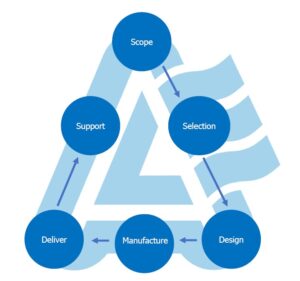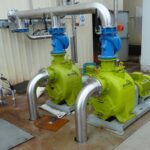Users often forget this, since most AODD applications are transfer applications with a relatively low viscosity fluid. While a complete discussion of more accurate methods for evaluating pump systems is beyond the scope of this article, pump users can employ the following techniques to estimate the factors that impact flow rates in AODD systems with high viscosity fluids.
Consider the following simple fluid transfer system in which the user wants to transfer 20 gallons per minute (gpm) using a 1-inch AODD. To determine if an application is possible, three questions must be answered:
- Can the pump draw fluid at the desired flow rate through the suction line? An appropriate answer to this question can be found by comparing the pump’s dry-lift rating to the suction line loss. In other words, does the pump’s dry-lift capability exceed the suction line loss at the desired flow rate?
- Can the pump overcome the system’s total dynamic head (TDH)? When considering AODD applications, it is beneficial to consider TDH in terms of pounds per square inch (psi) rather than feet of water (ft-H20O) for the simple reason that the energy source for AODDs is compressed air. If the air inlet pressure exceeds the system’s TDH, then fluid can be transferred in the pump system. For pump longevity, AODD users should strive to design systems that operate in the mid-range of the pump’s capabilities. No more than 60 psi of TDH is a reasonable design goal for most transfer systems.
- 3. To what degree should the pump be de-rated, given the operating conditions?
Most manufacturers publish viscosity correction curves. The curves, in effect, summarise the frictional losses that occur when viscous fluid pass through the pump.
Considering Question 1
To determine if the pump can draw in the process fluid, it is necessary to calculate the suction line loss for the desired flow rate.
A discussion of the mathematics of suction line loss is too in-depth for this article. However, pipe diameter and flow rate impact line loss tremendously. It is not uncommon to increase the diameter of the suction line loss. Consider the following results for suction line loss calculations in the example system in Figure 1.
A typical 1-inch AODD may have dry lift capabilities of 15ft-H2O or 6.5 psi. In practical terms, this means the pump cannot operate in systems where suction line loss exceeds 6.5 psi. Using a 1-inch suction line as depicted in Figure 1 results in a suction line loss that exceeds the pump’s capabilities. To meet the desired flow rate of 20 gpm, the suction line diameter must be increased to 2 inches. This increase reduces the suction line loss from 34 psi to 2 psi, well within the operating capabilities of the AODD pump.
Considering Question 2
To calculate the TDH of the entire system, both the total static head and the discharge frictional line loss must be determined. See the example system in Table 1.
The frictional line loss due to a 1-inch line exceeds the maximum operating pressure of most AODD pumps (120 psi). It becomes necessary to increase the discharge line diameter to reduce the losses to a level within the range of the AODD pump.
Increasing the discharge line diameter from 1 inch to 1-1/2 inches reduces the discharge line loss from 135 psi to 24 psi, a comfortable level for AODD pumps.
In the example system the static head is a simple calculation (10ft-H2O to 15 ft-H2O) x 1.2 S.G., or 6ft-H2O. Expressed in psi, the total static head is approximately -2.6 psi. Therefore, the system’s TDH is 31 psi – the sum of the static head and the frictional pipe losses.
Considering Question 3
The final step in the rough approximation is to consider the line losses as the process fluid moves through the pump. AODD manufacturers typically publish pump curves for water. Viscosity correction curves de-rate higher viscosities. For the example system, the manufacturer’s table advises that, with 1,500 cps the pump will operate at 88% of its published capacity. When reading the manufacturer’s published curves one should therefore read 20 gpm at 23 gpm (20 gpm/0.88).
Referring to the adjusted e3xample system, two changes were made- suction line diameter increased to 2 inches and discharge line diameter increased to 1.5 inches. Finally, we must determine the air-inlet pressure of the AODD.
Figure 2 is a typical example of a published pump curve from an AODD manufacturer. The horizontal axis typically represents the flow rate in gpm or litres per minute (lpm), and the vertical axis typically represents both system pressure and air operating pressure.
In Figure 2, the red lines represent air consumption in standard cubic feet per minute (SCFM) and the blue lines represent air inlet pressure in psi. Reading the curve for our sample system (23 gpm and 31 psi TDH) shows that air-inlet pressure should be set at approximately 55 psi and the pump will consume 22 SCFM of air while operating. It is important to note that exceeding the required air pressure of 55 psi can result in cavitation as suction line losses may exceed the capabilities of the pump.
In this simplified system analysis, may important factors have been ignored. However, this example demonstrates the impact system factors have on an AODD pump’s ability to process viscous fluids.
Viscosity and pipe diameter play a significant role in suction line loss and must be considered during evaluation. The system capabilities are limited by the pump’s suction lift capabilities and air-inlet pressure.





























































































